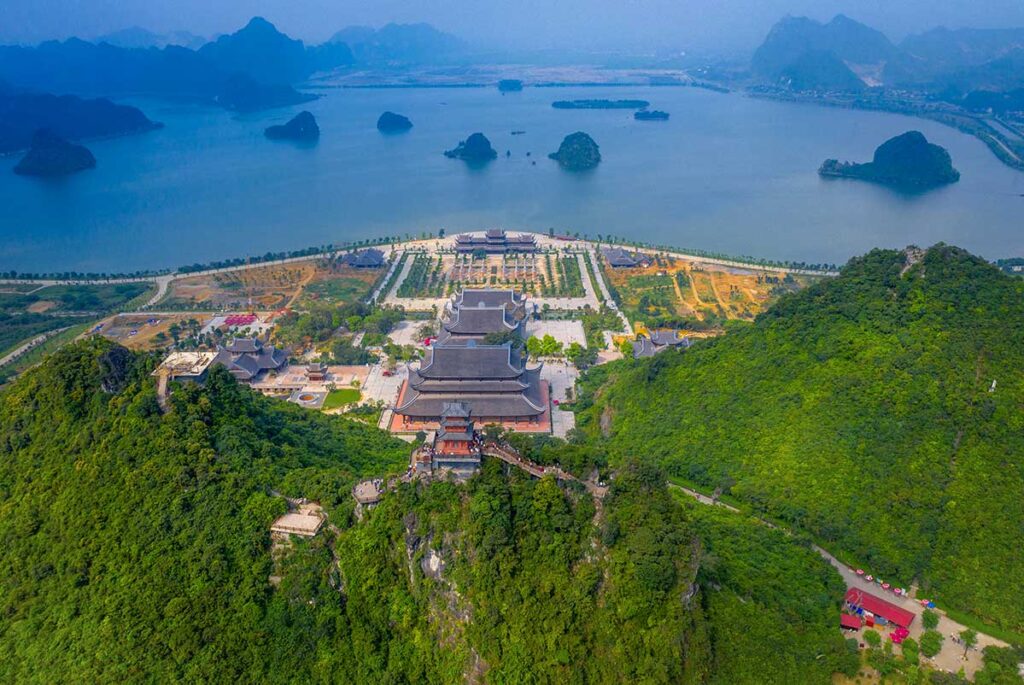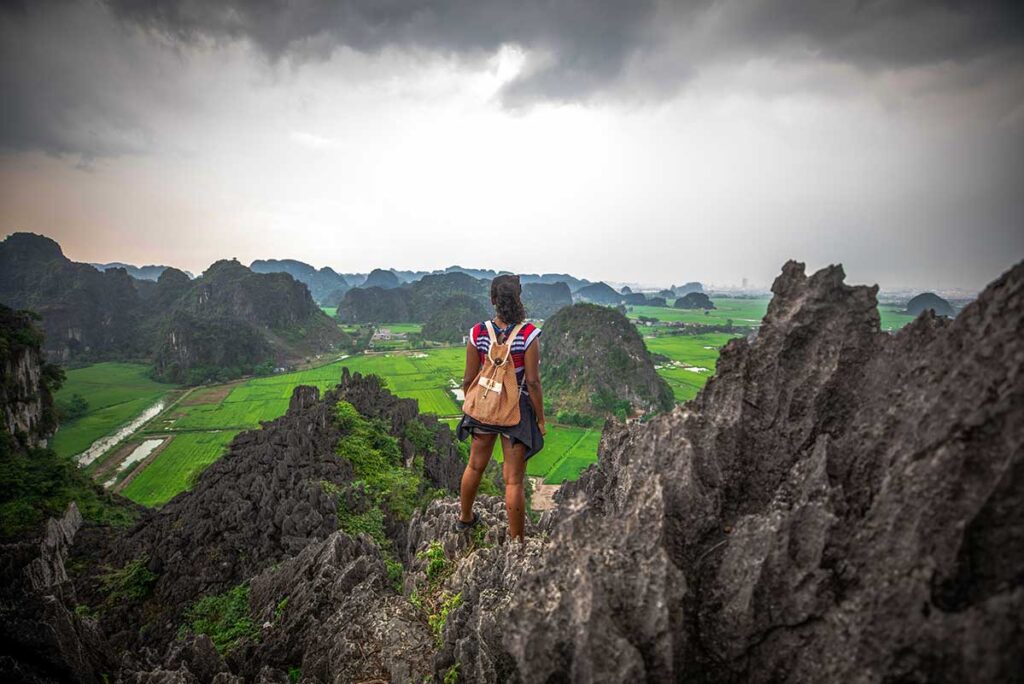What is Tam Chuc Pagoda?
Tam Chuc Pagoda is a vast Buddhist temple complex located in Ba Sao Town, Kim Bang District, Ha Nam Province—about 1.5 hours by car from Hanoi. Spread across a scenic area of lakes and limestone hills, it’s one of the largest spiritual sites in Vietnam, with enormous temples, stone pillar gardens, and sweeping views over the water. The complex combines religious function with grand-scale tourism, drawing millions of domestic visitors each year, especially during spring and major Buddhist holidays.
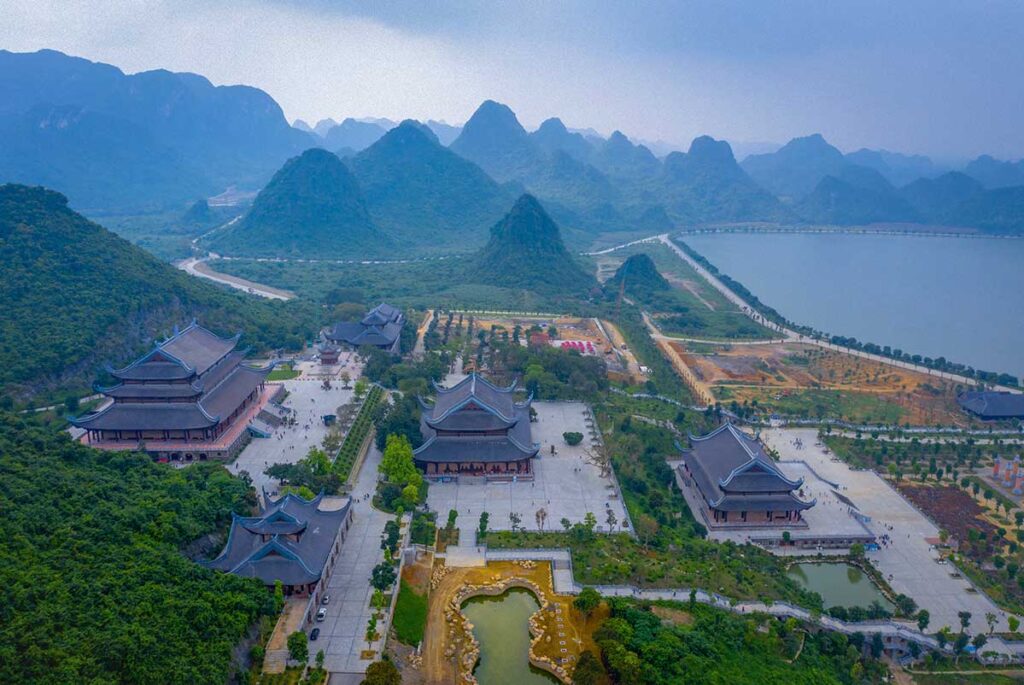
Although the original Tam Chuc Pagoda dates back over 1,000 years to the Dinh Dynasty, the version you see today was largely rebuilt and inaugurated in 2019. The design follows traditional Vietnamese Buddhist architecture but on a monumental scale—massive bronze statues, stone carvings from Indonesia, and a pagoda made of granite from India. Like Bai Dinh and other newly built temple sites, it’s part of a broader trend in Vietnam to develop mega-sized religious tourism zones combining faith, spectacle, and local sightseeing.
Visiting information
Opening Hours
- Open daily from 6:00 AM to 9:00 PM in high season (spring, festivals), and 6:00 AM to 6:00 PM during off-peak months.
- These times are subject to change—especially during festivals—so double-check before your trip.
Entrance Fees
- There’s no entrance fee to access the pagoda complex.
- However, the complex spans several kilometers—so unless you’re up for a long walk, most visitors take either an electric cart (~90,000 VND round-trip) or boat (~200,000–300,000 VND package) to get around efficiently.
Transportation Inside the Complex
- Electric carts: Convenient for reaching the Three Palaces; wheelchair-friendly. Note: some visitors mentioned long waits and occasional mismanagement, especially at peak times.
- Boat rides: Scenic way to reach inner temples and the communal house on the lake.
- Walking: Possible, but expect to cover 5+ kilometers if planning to see everything on foot.
- Accessibility: The site has wheelchair ramps and accessible restrooms, but help is often needed to board boats or cars—staff usually assist when asked.
Crowds & Quiet Times
- Peak crowd periods: February to April (Lunar New Year and Vesak), weekends, and Vietnamese public holidays.
- Midweek visits outside festival season are much calmer and more enjoyable.
- Ideal timing: Aim for weekday mornings (just after 6 AM) to avoid both heat and crowds.
Dress Code & Etiquette
- Dress modestly: shoulders and knees should be covered in temple areas.
- Maintain respectful behavior—keep voices low, silence phones inside halls, and don’t climb on statues.
- Shoes must be removed before entering main temple buildings.
Facilities & Food
- Restaurants/cafeterias: Basic quality and often report slow service; portions and pricing are what you’d expect at a tourist site.
- Toilets: Clean and accessible (including disabled facilities), though facilities near the far ends can be basic.
- Shaded seating areas scattered throughout—good for rest during long visits.
- Consider bringing your own water/snacks to avoid overpaying or long waits during busy periods.
International Visitors Tips
- Most signage and announcements are in Vietnamese only—be prepared to rely on translation apps or gestures.
- Few English-speaking staff on-site, and foreign-language guided tours are rare; private guides can be arranged in advance.
- Tip: Read our honest review —it explains whether this trip meets expectations for international travelers.
How to get there
Private car with driver
Booking a private car with driver is the most comfortable and straightforward way to reach Tam Chuc Pagoda—especially if you’re traveling with children, elderly travelers, or on a tight schedule. The ride from Hanoi takes about 1.5 hours, and you’ll be dropped off directly at the ticket area without having to navigate any transfers.
Private day tour from Hanoi
Several operators offer Tam Chuc day tours from Hanoi, often combined with nearby attractions like Trang An or Hoa Lu. However, most of these tours are aimed at Vietnamese tourists and conducted in Vietnamese. If you want a foreign-language guide, look specifically for private tour options. These usually include transport, entrance tickets, and lunch—but always double-check what’s actually included.
Via Phu Ly (Bus + Taxi)
You can take a public bus or limousine van from Hanoi (Giap Bat Station) to Phu Ly City, then continue by taxi to the pagoda (about 20 km). This option is cheaper but less convenient—only worth considering if you’re already staying in the area or want to combine your visit with other sights in Ha Nam.
By motorbike
You can reach Tam Chuc by motorbike in about 1.5 to 2 hours from Hanoi, but you must avoid the expressway, as motorbikes are not permitted. Instead, take National Road 1A (QL1A) and follow local roads through Thanh Liem District into Ba Sao Town. The route is longer and slower than by car, but it’s a scenic option for experienced riders. Make sure your license is valid in Vietnam and expect local traffic conditions.
Things to See and Do at Tam Chuc Pagoda
1. Thuy Dinh Guest House & Boat Dock
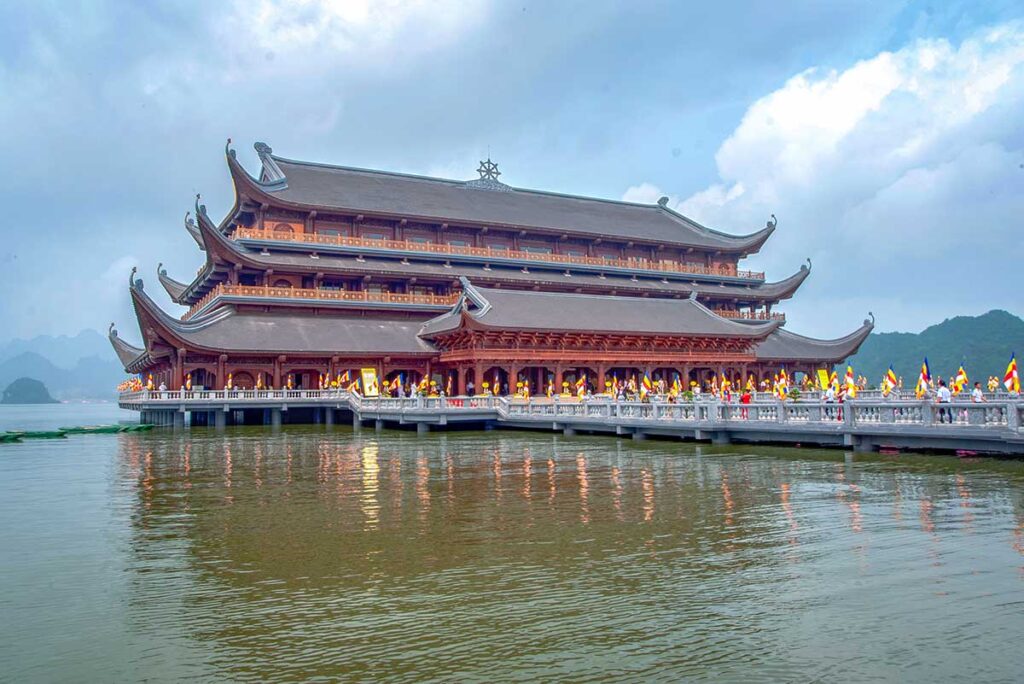
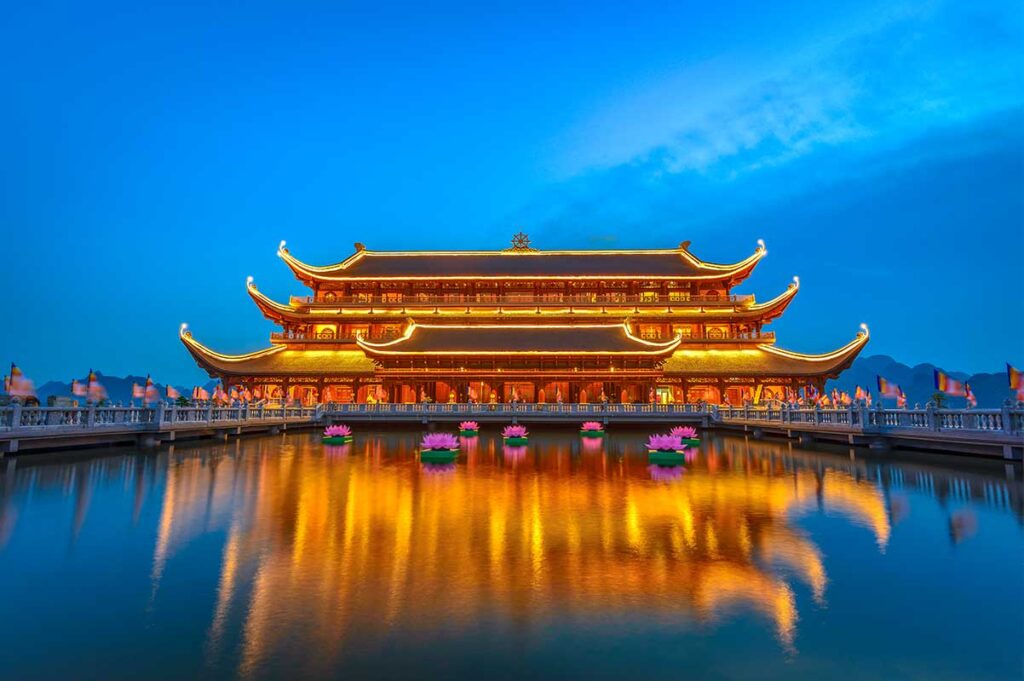
This is where most visits begin. The large, traditional-style building sits right by the lake and offers views of the surrounding hills and water. Inside, you’ll find ticket counters for boat and electric car transport. It’s also where you’ll return at the end of your loop. Expect crowds here, especially mid-morning. It’s a good spot to get your bearings, use the facilities, and decide how you want to move through the complex.
2. Boat Ride on Tam Chuc Lake
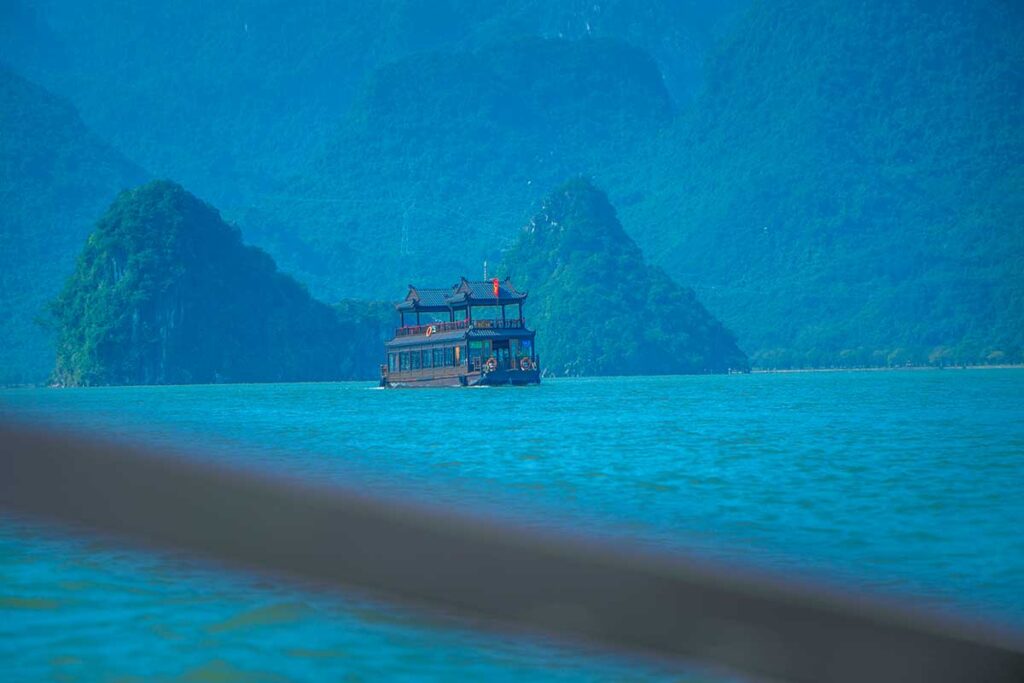
The boat ride is optional but recommended—not only for the scenery, but also to save energy. Boats depart from Thuy Dinh and glide across Luc Nhac Lake toward the temples. The limestone peaks and floating islets (said to resemble six celestial bells) create a peaceful, photogenic setting. Boats are motorized and run regularly, though wait times can increase during busy periods. The ride lasts about 15–20 minutes.
3. Tam Quan Gate
After disembarking from the boat, you’ll pass through the monumental Tam Quan Gate. This three-arched entrance features intricate carvings and a massive bronze drum at its center. It marks the formal entry to the inner temple zone and is one of the most photographed spots in the complex. The wide stone stairways and surrounding plazas also make it a gathering point for visitors and tour groups.
4. Kinh Pillar Garden (Sutra Pillars)
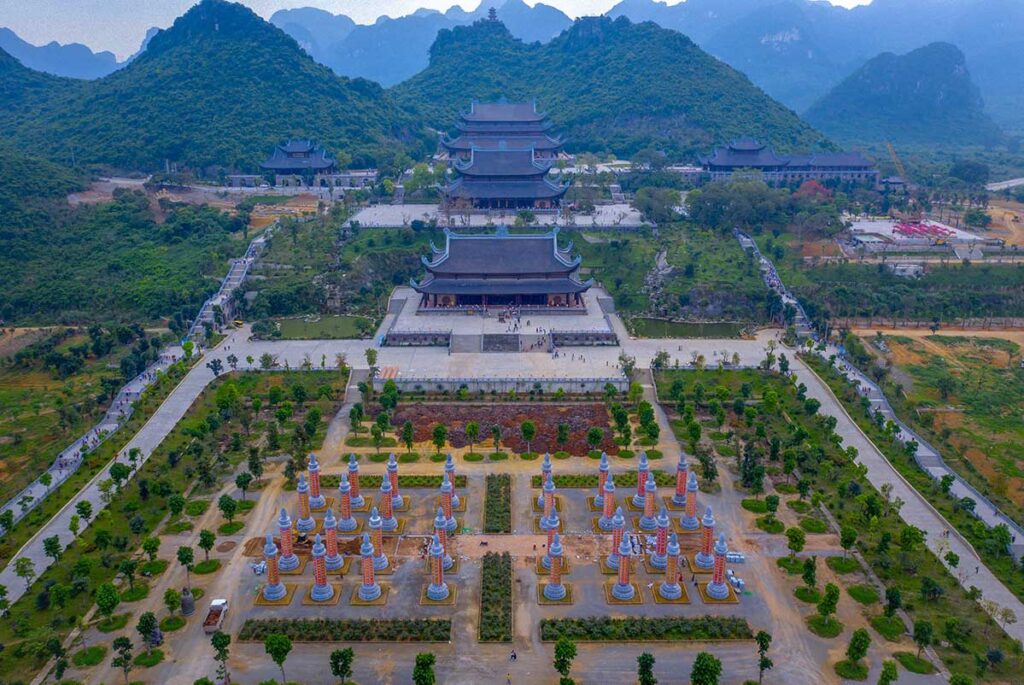
Just beyond the gate lies a garden filled with 32 towering green stone pillars, each weighing around 200 tons. These pillars are engraved with Buddhist sutras and rest on lotus-shaped bases. The layout feels ceremonial, like an open-air spiritual corridor leading to the temples. It’s one of the most visually striking parts of the complex, though interpretation is limited if you don’t read Vietnamese.
5. The Main Pagodas (Three Palaces)
The spiritual core of Tam Chuc consists of three grand halls lined up on the hillside.
Tam The Palace
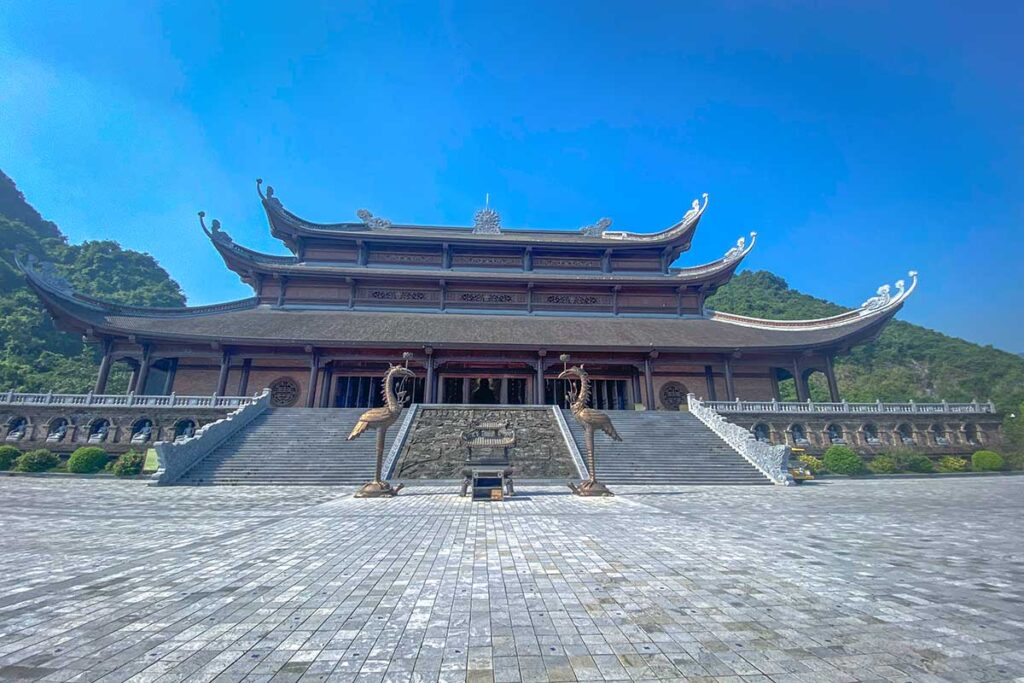
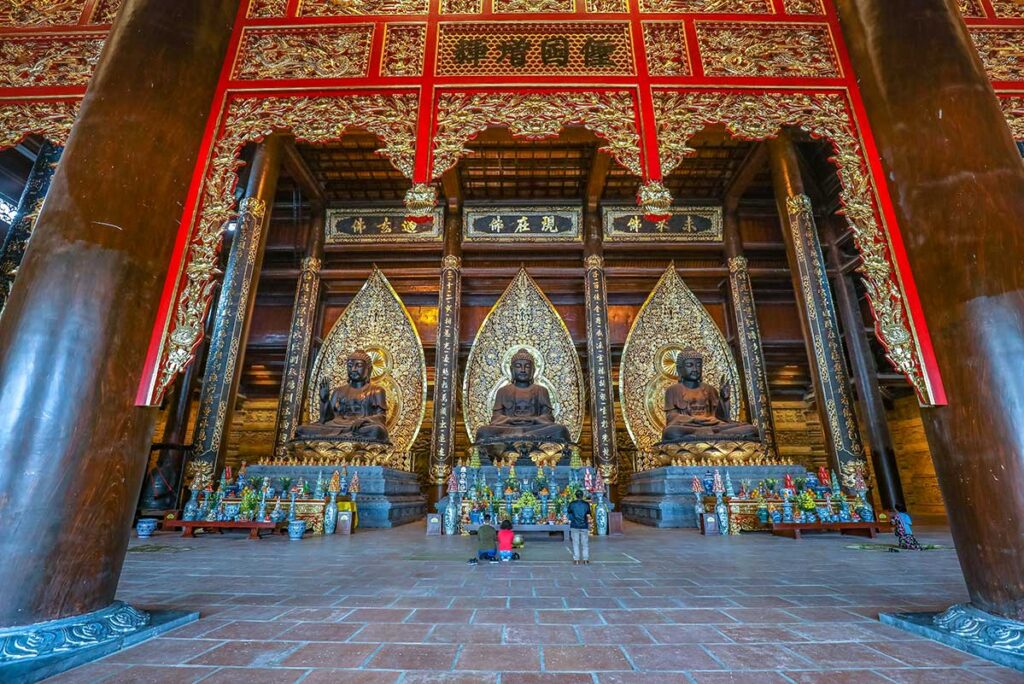
The largest of the three, Tam The houses three enormous bronze Buddha statues, representing past, present, and future. Each statue is over 10 meters tall and weighs dozens of tons. The walls are decorated with 12,000 volcanic stone reliefs depicting scenes from Buddha’s life. The scale is undeniably impressive, though the atmosphere may feel more awe-inspiring than meditative.
Phap Chu Palace
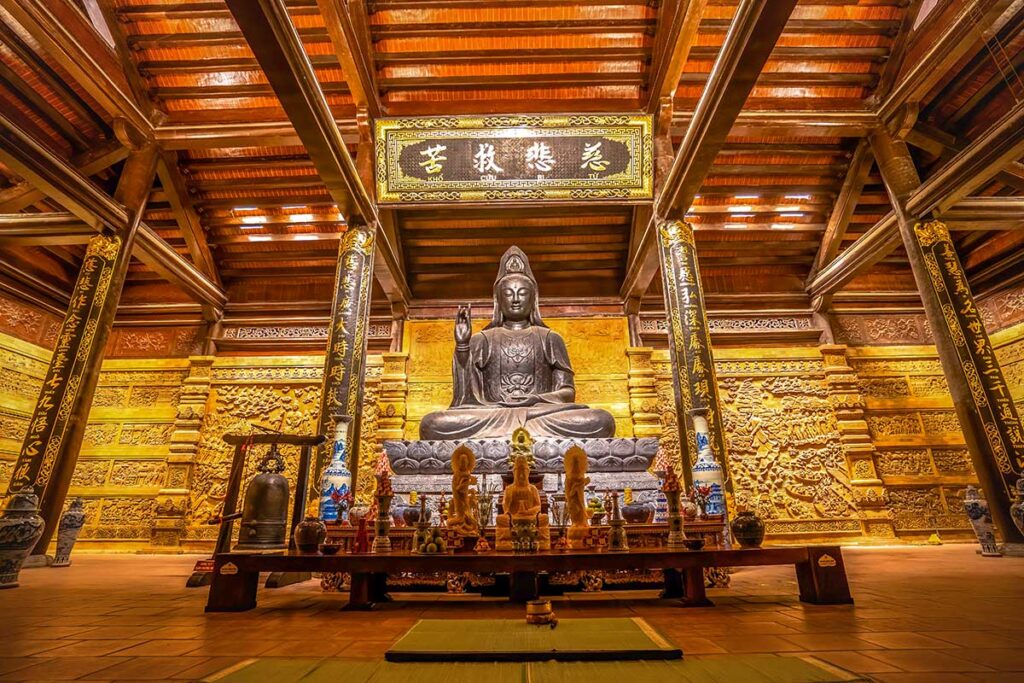
Dedicated to Shakyamuni Buddha, this hall features a 150-ton bronze statue that dominates the space. It’s said to be the largest of its kind in Southeast Asia. The hall is quieter than Tam The, with fewer visitors lingering.
Quan Am Palace
This final hall honors the Bodhisattva of Compassion, Quan Am. A single 100-ton bronze statue sits in the center. Carvings and decorative elements continue the massive scale, but the overall design is slightly more intimate than the other two.
6. Jade Pagoda (Ngoc Pagoda)
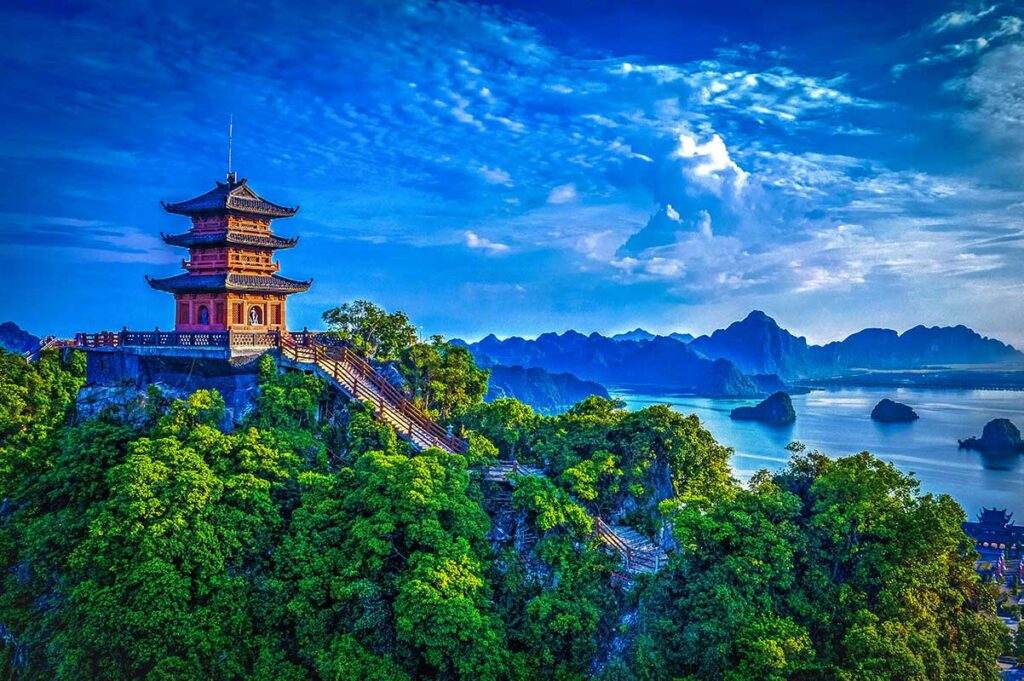
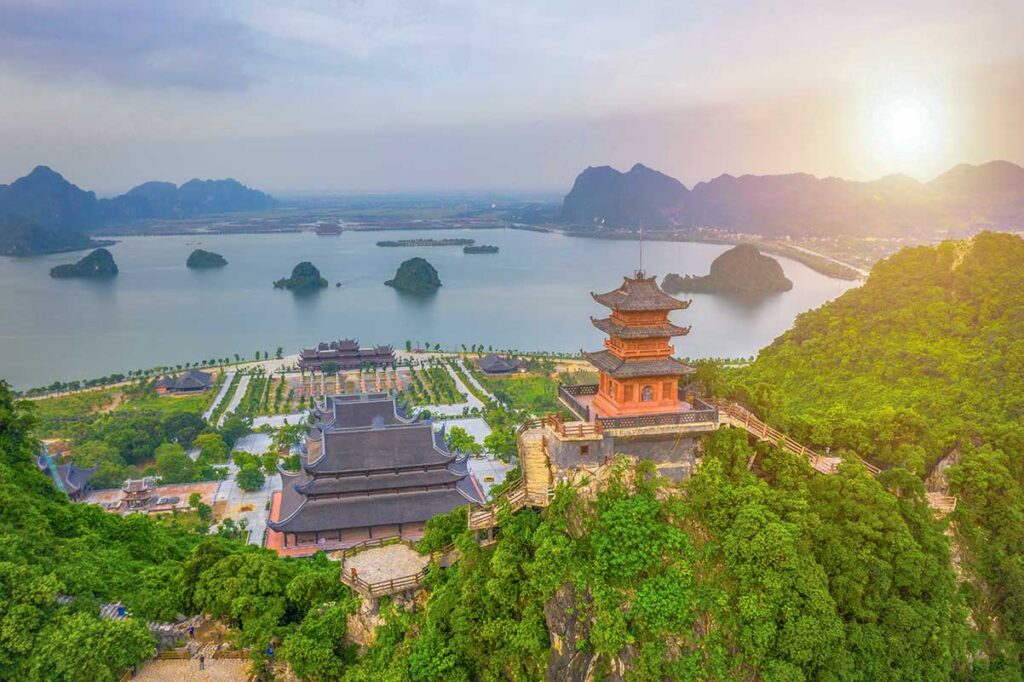
Set high on That Tinh Mountain, this red granite temple is one of the highlights of the complex. It’s small (just 13m²) but visually striking, and houses a 4,000-kg ruby Buddha statue. Reaching it requires climbing 299 stone steps, so it’s not suitable for everyone. On clear days, the view from the top is one of the best in the area.
7. Tam Chuc Communal House

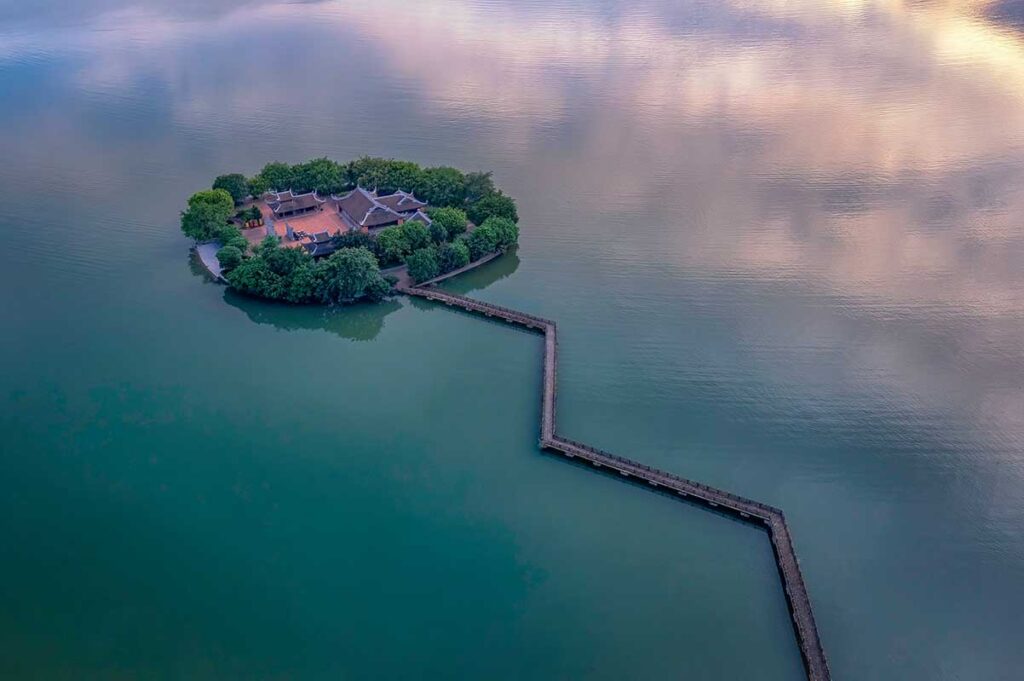
This quiet shrine sits on a small island in the lake, accessible only by boat. It’s dedicated to Queen Dinh Duong Thi Nguyet, a historical figure linked to the Dinh Dynasty. Surrounded by lotus blooms in summer, the setting is peaceful and less crowded. It offers a good contrast to the grandeur of the main halls.
8. Viewpoints & Photo Spots
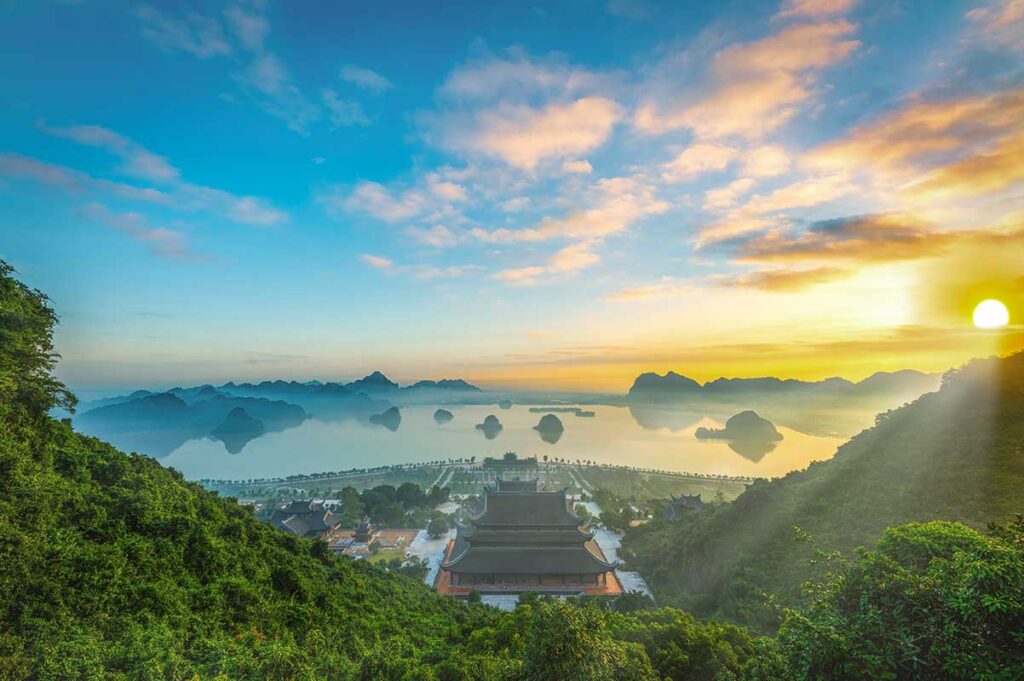
There are several natural and constructed viewpoints around the complex. The best are from near the top of the temple stairs and from behind the main halls. If you climb further behind the pagodas, you’ll reach quiet corners with panoramic views of the lake, temples, and limestone peaks—ideal for photography or simply taking a breather away from the crowds.
9. Kayaking & Afternoon Tea (Optional)
At the wharf near Thuy Dinh, you can rent kayaks or join a boat for afternoon tea, usually available between 16:30 and 18:30. These experiences are pleasant if you’re staying nearby or want to extend your visit, but they’re not essential if you’re short on time. As always, services vary in quality and may not be clearly advertised in English.
Is Tam Chuc Pagoda worth visiting?
Tam Chuc Pagoda is undeniably impressive in scale. The size of the temples, the dramatic lake-and-mountain setting, and the sheer ambition of the project make it one of Vietnam’s most visually striking spiritual sites. If you’re interested in architecture, Buddhist symbolism, or grand man-made environments, there’s plenty here to look at.
But beyond the surface, it often feels more like a showcase than a sacred space. Everything is new, polished, and built for scale, which can leave the experience feeling a bit hollow—especially if you’re looking for authentic atmosphere or historical depth. It’s part of a growing trend in Vietnam where spiritual tourism leans heavily into spectacle, and Tam Chuc is currently the most extreme example of that.
From a visitor’s perspective, the on-the-ground experience isn’t always smooth. Signage is mostly in Vietnamese, staff rarely speak English, and services like electric cars and restaurants are often mismanaged or inconsistent. During peak times—especially around Tet and spring festivals—the complex can feel overcrowded, hot, and frustrating to navigate.
So, is it worth it?
If you’re fascinated by giant religious monuments and want to see one of the biggest in the world, yes—Tam Chuc will leave an impression. But if you’re looking for cultural authenticity, a well-organized visitor experience, or a peaceful place to reflect, you’re better off visiting Bai Dinh Pagoda in Ninh Binh. It offers a similar blend of size and spirituality but is easier to combine with other sights and feels more integrated into the landscape.
